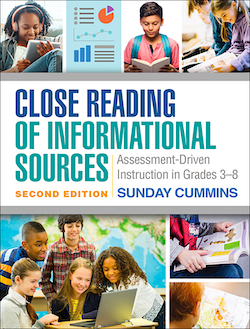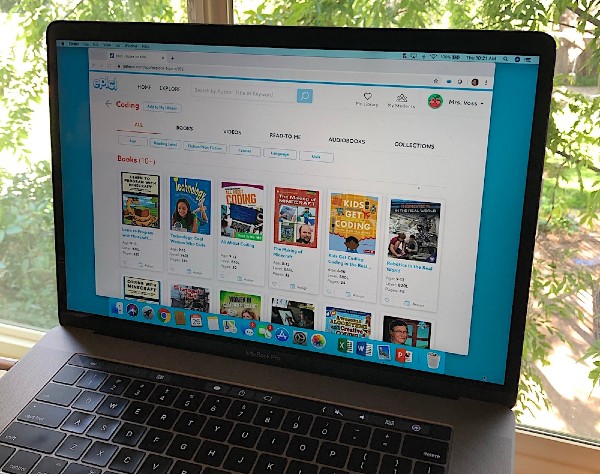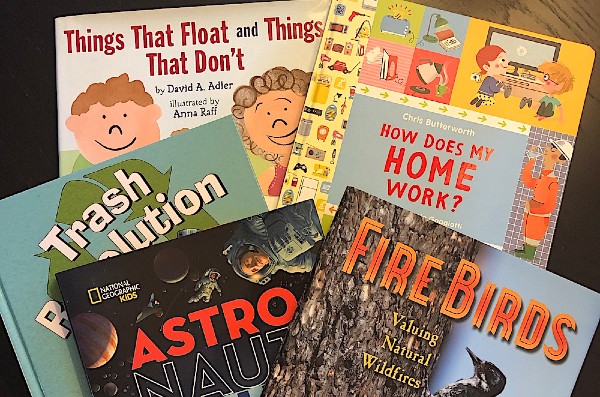How to Nurture a Passion for Reading Nonfiction
By Cate Gerard and Sunday Cummins
There’s so much good nonfiction out there for our students to enjoy for self-selected reading, and the benefits seem endless. Nonfiction has the power to inspire curiosity and continued learning and to transform how students view their world.

Sunday
Recently, Cate interviewed 13 middle grade students about their nonfiction reading habits. During Cate’s conversations, 10 out of 13 students revealed that they self-select primarily fiction books for independent reading. Why not nonfiction?
As Cate’s conversations proceeded, the students began to reveal what we, as teachers, might do to help them pick nonfiction more frequently for personal enjoyment.
Increase the presence of nonfiction.
Each time Cate started a conversation with students, she spread out a pile of nonfiction titles on a table nearby. The students’ eyes were immediately drawn to the books. They started to touch and notice. They couldn’t resist. We need to make sure appealing nonfiction books are easily available to students.
Quick suggestions:
In the classroom –
• Display nonfiction prominently – covers facing out.
• Organize nonfiction into bins for flipping and easy looking.
• Check out sets of books on the same topic or by the same author.
In the virtual classroom –
• Create virtual bookshelves of books on sites like Epic! that are free to educators, students and guardians.
• If a student has a library card, encourage them to access books through the site “Library to Go” or the Libby app.
• Encourage students to read from appropriate and appealing websites like San Diego Zoo Kids or Newsela.
Promote a wide variety of nonfiction.
During the interviews, Cate encouraged each student to pick a book from the pile she’d brought and then asked, “What do you notice?” Students jumped into conversation, pointing out photographs and other engaging features, sharing what they already knew about the topic and what they were wondering.
Noticing student interest, Cate would sometimes read aloud a particular part of the book, talking with the student about what they were thinking. Inevitably, the students wanted to read more or they’d mention another topic they wanted to read on. They seemed hungry for knowledge and yet there was the sense of, “How do I find books on this topic?” We need to continually promote the what, where, and how of finding and choosing books.
Quick suggestions:
In the classroom –
• Pick a book and project the cover (with a document camera or smart board). Then ask, “What do you notice?” If needed, think aloud about what you noticed that you might find making you want to read more!
• Read aloud excerpts with enthusiasm, sharing your thinking, your “Oh, my gosh” and “I wonder!” thoughts.
In the connected classroom –
• Why not book talk and read aloud the first few pages of a book you’d like students to find on a shelf at Epic!? Share your “Wow! I want to read more!” thinking with students.
• Create an online community of “Nonfiction Superstars” in Google classroom or using apps like Seesaw. Ask students to post photos of favorite parts of nonfiction books with short written responses or illustrated recommendations.
• Create high interest spaces to post recommendations for books with “the most amazing facts,” “the grossest facts,” “a book that changed how I see my world.”
Connect with students as they read nonfiction.
Part of the reason students enjoyed the interviews with Cate (and seemed to want to read more nonfiction) may have been because of Cate’s enthusiasm about nonfiction. Our students love being part of a learning community that includes their teacher. Reading conferences can be a great part of this co-learning experience.
Quick suggestions:
In the classroom –
• Lean in to individuals during self-selected reading time and ask simple questions like, “What do you like about this book so far?” and “What are you learning that you could share with me right now?”
• Check for understanding. Is the student making sense of the text in a meaningful way? If they are not, engage the student in a conversation that helps them make sense of what they’ve read as a way to launch more powerful learning.
• Ask students to pause and check in with each other. Provide questions they can ask to start a conversation like “What are you wondering about?” and “What questions do you have?”
In the connected classroom –
• Respond to students’ recommendations.
• Read a book a student has recommended (or part of it) for yourself. Let them know how the book was powerful for you, too.
• Ask students to reach out to you about parts they loved and parts they did not understand. Offer tips for making sense of the tricky parts.
All of the suggestions we have shared here are really focused on one idea – continuous exposure. This intentional attention may help us break through as revealed in one of Cate’s interviews.
At the beginning of the interview, Anna, a 5th grade student stated firmly, “I’m more of a fiction person.” Then, as they were parting, Cate asked Anna, “Since talking with me, do you think you’re more likely to pick up a nonfiction book?” Anna immediately grinned and responded with a confident “YES!”
Cate Stallmeyer-Gerard is an Elementary Teaching and Learning Coordinator for the Champaign Unit 4 Schools in Illinois. She is also an adjunct instructor in the Department of Curriculum and Instruction at the University of Illinois, Urbana Campus. She has been a literacy interventionist as well as both a literacy and an instructional coach. She attended the University of Illinois for her undergraduate and graduate degrees, receiving her doctorate in Curriculum and Instruction.

She is a graduate of Teachers College, Columbia University and has a doctorate in Curriculum and Instruction from the University of Illinois, Champaign Urbana. Visit her website and read her regular blog posts on teaching information literacy. Follow Sunday on Threads.





































